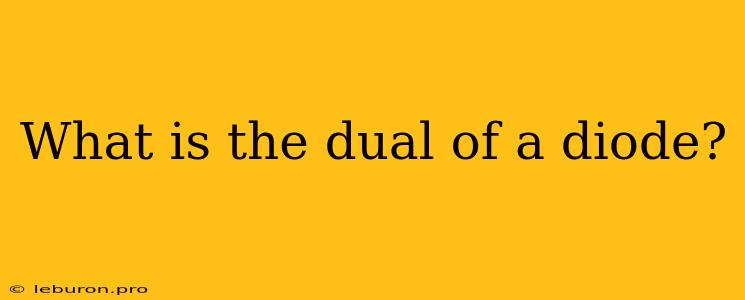In the realm of electronics, diodes are ubiquitous components known for their unidirectional current flow. They allow current to pass easily in one direction while blocking it in the opposite direction. But what about the opposite scenario, a component that allows current flow in one direction but blocks it in the other? This concept leads us to the fascinating world of the dual of a diode, a component that exhibits the inverse behavior of a diode.
Understanding the Concept of Duality
Before delving into the specifics of a diode's dual, let's understand the fundamental principle of duality in electronics. Duality refers to the idea that every electrical circuit or component has a corresponding counterpart with opposite characteristics. This concept arises from the symmetry of Maxwell's equations, which govern the behavior of electromagnetic fields.
For example, the dual of a resistor is a capacitor, the dual of a current source is a voltage source, and the dual of an inductor is a capacitor. Each of these pairs exhibits complementary behaviors in terms of how they store and release energy.
The Dual of a Diode: The Thyristor
Now, let's turn our attention to the dual of a diode, a component known as a thyristor. While a diode allows current to flow only in one direction, a thyristor exhibits a unique switching behavior. A thyristor can be triggered into conduction by a short pulse of current, and once it is conducting, it remains in that state until the current through it falls below a certain threshold.
Working Principle of a Thyristor
To understand the working principle of a thyristor, let's consider a basic thyristor structure: it consists of four layers of semiconductor material, typically silicon, with alternating n-type and p-type regions. This structure creates three junctions within the thyristor, denoted as J1, J2, and J3.
-
Forward Blocking State: When a positive voltage is applied to the anode and a negative voltage to the cathode, the J1 and J3 junctions are reverse biased, and the J2 junction is forward biased. In this state, the thyristor acts as an open circuit, blocking current flow.
-
Forward Conduction State: When a small positive voltage is applied to the gate, the J2 junction becomes forward biased, allowing a small current to flow through the gate. This current triggers the thyristor into conduction, effectively reducing the resistance between the anode and cathode. The thyristor now acts as a closed switch, allowing a large current to flow through it.
-
Holding Current: Even after the gate signal is removed, the thyristor will continue to conduct as long as the current flowing through it exceeds a certain minimum value, known as the holding current. Once the current falls below this threshold, the thyristor reverts back to its forward blocking state.
Applications of Thyristors
Thyristors have found widespread applications in various electronic circuits and systems, including:
-
Power Control: Thyristors are used in AC to DC converters, motor speed controllers, and power factor correction circuits to regulate the flow of power.
-
Switching Applications: They are used in power supplies, inverters, and other switching circuits to control the flow of current in a controlled manner.
-
High-Power Applications: Thyristors are used in high-power applications like electric trains, welding machines, and industrial heating systems.
Differences Between Diodes and Thyristors
While diodes and thyristors are both semiconductor devices, they differ significantly in their behavior and applications. Here's a summary of the key differences:
| Feature | Diode | Thyristor |
|---|---|---|
| Conduction mechanism | Unidirectional current flow | Triggered conduction, holding current |
| Number of layers | Two | Four |
| Number of junctions | One | Three |
| Gate control | Not applicable | Triggering and holding current |
| Applications | Rectification, signal processing, protection circuits | Power control, switching, high-power applications |
Conclusion
The dual of a diode, the thyristor, is a remarkable device that exhibits a unique switching behavior, offering a wide range of possibilities for controlling and regulating power in electronic systems. Its ability to switch from a blocking state to a conducting state under the control of a gate signal makes it an essential component in many high-power applications. Understanding the duality concept allows us to appreciate the interconnectedness of different electronic components and their roles in shaping the world of electronics.
